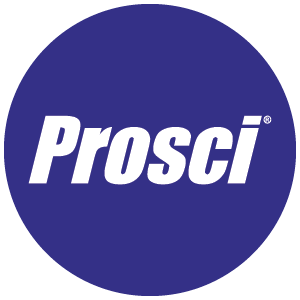Change Management Process

7 Mins
Updated: April 22, 2025
Published: July 1, 2024

Change management is crucial for successful organizational change. Our research shows that businesses that apply effective change management are up to seven times more likely to reach their project objectives.
However, to adequately implement change management, you need to use a structured and actionable process that guides organizations, individual leaders, managers and employees through the transition. This process requires flexible yet detailed frameworks like the Prosci 3-Phase Process and Prosci ADKAR® Model.
In this article, we’ll explain the change management process and how practitioners can leverage Prosci frameworks to achieve change success.
What is the Change Management Process?
Change management is a structured approach to preparing, equipping and supporting individuals through organizational change. It involves planning and implementing a change with minimal disruption and maximum adoption.
The change management process is the collection of steps an organization needs to take and the activities they need to perform to move from a current state to a desired future state.
To show how change management takes place within an organization, Prosci developed the Unified Value Proposition (UVP) model. This organizing framework highlights how the technical and people sides of change work together to achieve a common goal of success.
You can think of the UVP as "change management on a page."
Unified Value Proposition (UVP)

In the UVP model, every change starts with a reason for the change. These could be current conditions, future goals, or internal or external factors. Common reasons for change include market shifts, potential for increased revenue, improved efficiency or a larger market share.
Once the reason for the change is determined and the initiative has started, organizations progress through three states:
- The current state – This is the present state of business processes, systems and company culture. It’s familiar to employees and leaders.
- The future state – In the future state, organizations see improvement in one or more areas of the organization as a result of the change initiative.
- The transition state – To move from the current state to the future state, organizations must help people alter the way they work and think. This process is not linear and can be ambiguous, causing uncertainty and fear among the people it impacts.
To successfully progress from one state to the next, organizations must focus on two crucial sides of change: the technical side and the people side.
The technical side of change includes designing and delivering a solution that addresses the reason for the change. For example, during the implementation of electronic health records (EHR), the technical side involves changes in software, hardware, policies and roles. The project management or solutions development team is usually responsible for the technical side of the change process and execution.
The people side of change involves guiding and supporting individuals in accepting and adopting the new solution or change. In the EHR implementation process, change practitioners can help communicate the benefits across the entire organization, enable training, and support people during the change so they can use the new software in their work. The change management process leads teams through this transition.
For any change to be successful, the people involved must be empowered to adopt and use it. So, your change management process needs to support individuals to maximize engagement and adoption, and to prevent or reduce resistance.
Through decades of research, we developed the Prosci Methodology to enable success through structured processes. These include a process for achieving organizational change, the Prosci 3-Phase Process, and a model for individual change, the Prosci ADKAR Model. Combining these with the Prosci Change Triangle (PCT) Model helps change practitioners create actionable and accessible strategies for change success.
Change Process Management: Prosci 3-Phase Process
The Prosci 3-Phase Process is a structured, repeatable and adaptable approach for organizational change management.
This practical framework is a critical link between individual change management and organizational change, enabling practitioners to leverage and scale change activities that help impacted individuals move through their transitions.
Prosci 3-Phase Process

The Prosci 3-Phase Process guides you through the crucial steps and activities required during projects and initiatives, so you can achieve successful change outcomes.
Every phase in the 3-Phase Process ends with a key deliverable that enables you to summarize and communicate progress to others. Each deliverable is flexible, customizable and scalable to fit your unique project and organization. Ending each phase with a tangible document increases commitment and understanding of the change management process while ensuring stakeholder alignment.
Let’s examine each phase more closely to understand what an effective change management process can look like:
Phase 1 – Prepare Approach
During this initial phase, practitioners prepare the change management approach to be applied across three stages:
- Define Success – What are we trying to achieve?
- Define Impact – Who has to do their jobs differently and how?
- Define Approach – What will it take to achieve success?
The purpose of this initial phase is to position the change for success by developing a customized, scaled change management strategy along with the sponsorship and commitment you need.
Gaining support from the primary sponsor and key stakeholders in this phase is critical. Without early commitment, the support you need may never materialize, significantly jeopardizing success.
The deliverable for Phase 1 – Prepare Approach is the Change Management Strategy, which informs the activities in Phase 2 – Manage Change.
Phase 2 – Manage Change
During this phase, practitioners develop specific plans to move impacted individuals and the organization through their ADKAR transitions, and learn how to measure, track and adapt performance. This is the longest phase and the most visible to organizations and impacted individuals.
The bulk of the change management team's work gets done in the stages of this central phase:
- Plan and Act – What will we do to prepare, equip and support people?
- Track Performance – How are we doing?
- Adapt Actions – What adjustments do we need to make?
The purpose here is to enable employees to adopt the initiative or project solutions. During Phase 2, as a practitioner, you can leverage AI tools like Kaiya™, Prosci's expert change management AI tool, to answer questions, guide employees and stakeholders, ensure you address their unique concerns, and support their transitions effectively.
Change management plans depend on your unique organization and your project or initiative. Phase 2 – Manage Change culminates with the Master Change Management Plan deliverable.
Phase 3 – Sustain Outcomes
In this final phase of the Prosci 3-Phase Process, the organization achieves the project's benefits and focuses on sustaining the outcomes. Key activities take place in three stages:
- Review Performance – Now, where are we?
- Activate Sustainment – What is needed to ensure the change sticks?
- Transfer Ownership – Who will assume ownership and sustain the outcomes?
The purpose of this phase is to reach the desired change outcomes and then equip the organization to sustain the adopted changes over time.
After assessing the performance using key performance indicators (KPIs) and data analysis, Phase 3 – Sustain Outcomes culminates with celebrating successes and transferring ownership of long-term sustainment activities to the appropriate operational team members. The deliverable for Phase 3 – Sustain Outcomes is the Change Management Closeout, which ends the formal change management effort for the initiative.
Implementing the 3-Phase Process ensures organizations are well-prepared for change by assessing readiness and defining clear goals. It also helps practitioners create detailed plans to effectively manage change at every stage.
Throughout the change management process, change practitioners apply the PCT Model to track and maintain project health. They focus on four critical aspects of change: success, leadership/sponsorship, project management, and change management. The PCT Assessment further supports project health by providing ongoing insights throughout the transition.
The 3-Phase Process scales the individual change management process and ADKAR Model, bridging the gap between individual change management and organizational change management.
Individual Change Management: ADKAR Model
Organizational change starts with individual change. For a change management process to succeed, employees need to be informed, supported, and empowered to adopt and sustain the change. This is where the Prosci ADKAR Model comes in.
Developed by Jeff Hiatt, the ADKAR Model represents five essential outcomes—awareness, Desire, Knowledge, Ability and Reinforcement—that all individuals need to successfully make a change. A successful transition results in adoption.
Prosci ADKAR Model

Let's take a deeper look at each of the five ADKAR building blocks and their role in the management of the change process:
Awareness
A lack of awareness about the reasons for change is the top reason for resistance cited in Prosci research. The first building block of the ADKAR Model, Awareness answers critical questions like "Why is this change happening?" and "What are the risks of not changing?"
Building awareness in people during the change management process reduces confusion and mitigates resistance behaviors by ensuring that they understand the reasons for change. Effective communication is key. An effective Communications Plan enables you to effectively identify audiences, develop messages, and set communication strategies, including frequency and delivery.
Senior leaders play a pivotal role in this stage by serving as visible and active sponsors—one of the most important contributors to successful change.
Contributors to Success Over Time
 The change management team uses the Sponsor Plan—a recommended role-based Core Plan—to target the Awareness, Desire and Reinforcement elements of the ADKAR Model. The plan helps leaders be active and visible sponsors, build a coalition of support, and engage with employees. The Sponsor Start-Up Checklist can help you align with best practices when you support leaders in these employee-facing responsibilities.
The change management team uses the Sponsor Plan—a recommended role-based Core Plan—to target the Awareness, Desire and Reinforcement elements of the ADKAR Model. The plan helps leaders be active and visible sponsors, build a coalition of support, and engage with employees. The Sponsor Start-Up Checklist can help you align with best practices when you support leaders in these employee-facing responsibilities.
Desire
Desire is the personal choice to support and participate in the change. This ADKAR element answers, "What's in it for me?"
Even if employees are aware of the change, they may not engage unless they see personal or organizational benefits. Strong leadership, trust in sponsors, and proactive resistance management are vital in fostering desire. In fact, focusing on resistance prevention early in the process has a higher potential for success than responding to resistance behaviors later on.
One of the top motivations for individuals to participate and engage in a change is their willingness to follow a leader they trust. In the Desire stage and beyond, active manager support increases employee commitment, and Prosci research shows that engaging people managers is one of the top contributors to change management success.
Change practitioners should work with people managers to ensure they fulfill their roles as advocates for change. The Prosci People Manager Plan—a recommended Core Plan that targets all elements of the ADKAR Model—equips people managers with the skills they need to guide their teams.
It's important to note that people managers are people first. They will experience their own resistance to change. Only when managers are committed to the change can they effectively engage with front-line employees and guide them through their individual change journeys.
Knowledge
During organizational change, employees must master two areas of knowledge—how to change (what to do during the transition) and how to perform effectively in the future state. Organizations use training and education, one-on-one coaching, user groups and forums, and troubleshooting guidance to help employees build this knowledge.
Change practitioners can support employees in achieving the Knowledge element of the ADKAR Model by creating a training plan as part of the change management process. In this plan, they define the different audiences that need project-specific training, conduct a needs assessment and gap analysis, and document the requirements.
Ability
Ability is the stage of the ADKAR Model where individuals apply their knowledge and demonstrate the new skills or behaviors required by the change. It addresses the question, "Can I actually do this?"
Practice, coaching and feedback are essential to building confidence and competence. Adequate support is necessary to prevent resistance due to skill gaps or other barriers. Additional challenges when building Ability include psychological blocks, poor support and personal limitations, which can also hinder successful individual change and increase resistance behaviors.
Practitioners identify these challenges by performing an ADKAR Assessment. Learning to analyze the assessment, identify the root causes of resistance, and resolve change barriers will help you prevent change resistance before it starts.
Reinforcement
Reinforcement ensures that change sticks. It focuses on sustaining the change over the long term, so individuals don’t revert to old ways of working. Reinforcement also creates a culture of continuous improvement among employees that drives further innovation and growth.
Prosci research shows that 81% of participants who planned for reinforcement or sustainment activities met or exceeded objectives.
Impact of Planning for Reinforcement on Project Success
 While the final phase of the 3-Phase Process focuses on sustaining change at the organizational level, ADKAR activities for reinforcement are tailored for individuals and teams.
While the final phase of the 3-Phase Process focuses on sustaining change at the organizational level, ADKAR activities for reinforcement are tailored for individuals and teams.
Standard reinforcement activities include publicly visible performance measurement, project-sponsored celebrations, rewards and recognition, feedback, corrective actions and accountability mechanisms.
These tactics motivate employees to continue applying the change even after the project is considered complete. This is especially important to deliver long-term value for modern organizations with multiple change initiatives. It ensures employees actually adopt a change in their work instead of abandoning it when the next project starts.
Create Your Change Management Process With Prosci
The Prosci Methodology—which includes our ADKAR Model, PCT Model, and 3-PhaseProcess—provides a comprehensive approach to managing both organizational and individual change. By integrating these frameworks, organizations can create a tailored change management process that drives success at every level.


